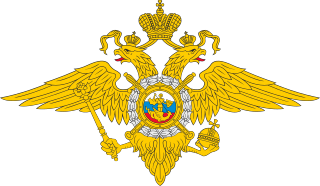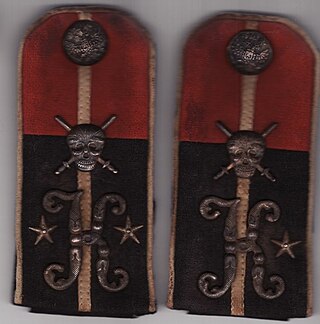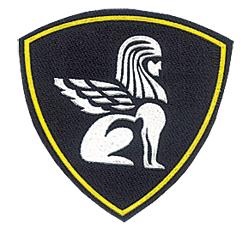
The Soviet Air Defence Forces was the air defence branch of the Soviet Armed Forces.

Modern Russian military ranks trace their roots to the Table of Ranks established by Peter the Great. Most of the rank names were borrowed from existing German/Prussian, French, English, Dutch, and Polish ranks upon the formation of the Russian regular army in the late 17th century.
The Main Directorate of State Security was the name of the Soviet Union's most important security body within the People's Commissariat of Internal Affairs (NKVD) USSR. At the time of its existence, which was from July 10, 1934 to February 3, 1941, the GUGB reflected exactly the Secret Operational Directorate within OGPU under the Council of People's Commissars, which operated within OGPU structure from 1923 to 1931/32. An intelligence service and secret police from July 1934 to February 1941, it was run under the auspices of the Peoples Commissariat of Internal Affairs (NKVD). Its first head was first deputy of People's Commissar of Internal Affairs, Commissioner 1st rank of State Security Yakov Agranov.
Army general was a rank of the Soviet Union which was first established in June 1940 as a high rank for Red Army generals, inferior only to the marshal of the Soviet Union. In the following 51 years the Soviet Union created 133 generals of the army, 32 of whom were later promoted to the rank of marshal of the Soviet Union. It is a direct counterpart of the Russian Federation's "Army general" rank.

Internal troops, sometimes alternatively translated as interior troops or interior ministry forces, are a paramilitary and gendarmerie-like law enforcement services, which are found mostly in the post-Soviet states, primarily Russia. Internal troops are subordinated to the interior minister of their respective countries.

The military ranks of the Soviet Union were those introduced after the October Revolution of 1917. At that time the Imperial Russian Table of Ranks was abolished, as were the privileges of the pre-Soviet Russian nobility.

The telnyashka is a horizontally striped undershirt worn as uniform by Russian military personnel. It has stripes in white and in a color that varies according to the unit's affiliation. The most common second color is blue, but a number of other colors are also in use. The garment comes in varying thicknesses and may be sleeved or sleeveless.

The Border Service of the Federal Security Service of the Russian Federation is a branch of the Federal Security Service of Russia tasked with patrol of the Russian border.
The Soviet Ground Forces, successor to the Red Army, the title changing in 1945, employed a wide range of different military formations.

The Ground Forces of the Armed Forces of the Soviet Union was the land warfare service branch of the Soviet Armed Forces from 1946 to 1992. In English it was often referred to as the Soviet Army.

The Internal Troops of the Ministry for Internal Affairs of the Russian Federation was a paramilitary force of the Ministry of Internal Affairs of Russia from 1991 to 2016.
The 8th Motorized Rifle Division of the NKVD Internal Troops was formed in accordance with NKVD Order Number 0021 from January 5, 1942, during execution GKO decree number 1099- ss on January 4, 1942. It was based on the 23rd Motorized Rifle Division NKVD Internal Troops.
Individual rank insignia to the (Army) ground forces and (Navy) naval forces (1935–1940) were established by orders 2590 and 2591, effective from September 22, 1935.
The ranks and rank insignia of the Soviet Armed Forces between 1955 and 1991 were distinguished by the reorganisation of the Soviet armed forces after the death of Stalin, resulting in changes to ranks, insignia, and uniforms.
Ranks and insignia of the Russian Federation's armed forces from 1994 to 2010 were affected by the disintegration of the former Soviet armed forces, and there were other changes in insignia design when the newly established Russian Federation came into existence. The ranks depicted below were replaced with those adopted by decree № 293 of the President of the Russian Federation on 11 March 2010. The transition began with the issue of new military uniforms to the armed services in 2008 in the Moscow area and in 2010 nationwide. The ranks of marshal of the branch and chief marshal were officially abolished as a result of the 1994 regulations.

The Russian Aerospace Forces or Russian Air and Space Forces comprise the aerial, space warfare, and missile defence branches of the Armed Forces of the Russian Federation. It was established on 1 August 2015 with the merging of the Russian Air Force (VVS) and the Russian Aerospace Defence Forces (VVKO), as recommended by the Ministry of Defence to improve efficiency and logistical support. The VKS is headquartered in Moscow.

The extensive system of uniforms of the Russian Armed Forces was inherited from the Soviet Armed Forces and modified across the years.

The Internal Troops of Kazakhstan was a militarized police force that operated in the Republic of Kazakhstan from 1992 to 2014. The Internal Troops formed the basis for what is now the National Guard of Kazakhstan.

Military ranks and insignia of the White Movement (1918-1922) were based on the former Ranks and insignia of the Imperial Russian Armed Forces. However, there were new features and modifications compared to the old system:

The Northwestern Order of the Red Star National Guard District is a district of the National Guard Forces Command of the Russian Federation.































